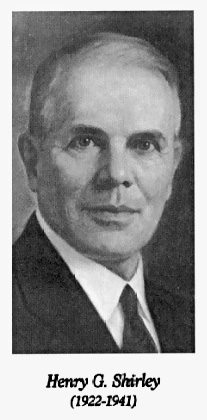
November 21, 2013
AASHTO Presidential Profile: Henry G. Shirley, Maryland

At the first official meeting of the American Association of State Highway Officials (AASHO) on Dec. 12, 1914, at the Raleigh Hotel in Washington, D.C., delegates selected Henry Garnett Shirley as the new association's first president.
Shirley was one of the people who helped to lay the groundwork for the entire organization as we know it today. He also was AASHTO's only president who served more than one term.
Shirley was born on Oct. 28, 1874 in Locust Grove, W.V., to Robert and Julia Baylor Shirley. He graduated from the Virginia Military Institute with a degree in civil engineering in 1896, and went on to serve as commandant and professor of military science at Horner Military School in Oxford, North Carolina. In addition, Shirley earned a doctorate of science from the University of Maryland.
Shirley was an officer in the U.S. Volunteers during the Spanish-American War in 1898. He then embarked on his longtime career in transportation, which initially involved railroads. Shirley worked for a various railroad companies, including the New York Central and Hudson River Railroad, West Virginia Central Railroad, and Baltimore and Ohio (B&O) Railroad.
During his time with the B&O, he worked on a planned railroad line to span Pennsylvania and was in charge of the tunnels that were cut through mountains for that purpose. While plans for that railroad line were ultimately abandoned, those tunnels did become part of the Pennsylvania Turnpike that now runs along that route.
Shirley also worked for the engineering department of the District of Columbia, and then became roads engineer for Baltimore County in Maryland. He then became chief engineer of the Maryland State Roads Commission, which was the forerunner of today's Maryland Department of Transportation, and proved instrumental in making that state's highways among the most modernized in the nation.
During that time, Shirley also helped organize AASHO. He was among the 14 state engineers who, while meeting in Atlanta in November 1914 (link to How it Began on web site), discussed and agreed upon establishing such an association to better address and promote their shared highway priorities. Chosen to be AASHO's first president the following month in Washington D.C., Shirley would be re-elected in 1915 at the annual meeting in Chicago – the only association president to date to serve two terms.
Shirley's accomplishments during his two terms as president between 1914 and 1916 included spearheading efforts to develop and advocate for the Federal-Aid Road Act of 1916, which was signed into law by President Woodrow Wilson and set the stage for a federal-state partnership committed to sustaining a viable network of highways throughout the nation.
Shirley's years after serving as AASHO president likewise proved to be anything but uneventful. During the U.S. involvement in World War I, for example, he served on the Highway Transport Committee of the Council of National Defense and in that capacity sought to help keep the nation's roads in the best possible condition for the movement of military troops and supplies. In addition, Henry served as executive secretary of the Federal Highway Council. He also headed the Highway Industries Association, a trade group organized during the war to advocate for the creation of a federal highway commission to build a 50,000-mile national highways network.
In 1920, Shirley went back to serving once more as Baltimore County's roads engineer. His major achievements included an ambitious road building program for the residential communities in that county that were very much under development by that time.
He was appointed chairman of Virginia's State Highway Commission in 1922 and continued in that capacity under a total of five governors and longer than anybody else (with his title ultimately changed by legislative action to state highway commissioner). The Norfolk Virginia-Pilot newspaper proclaimed that “one would have to search far in the state's annals to find a comparable public career,” and Shirley was widely credited for his efforts to improve and expand Virginia's highways system.
Shirley also promoted plans for the state's first limited-access highway to extend from U.S. Route 1 in Northern Virginia to the 14th Street Bridge in D.C. That road, which is now part of Interstates 95 and 395, was completed after his death and named the Henry G. Shirley Memorial Highway in his honor.
Shirley also continued his active involvement in AASHO. He had been on the association's Executive Committee in 1917, and again served in that capacity starting in 1929.
Shirley remained both Virginia's highway commissioner and a member of the AASHO Executive Committee until his death at his home in Richmond at the age of 66 on July 16, 1941. He had married Alice Robertson Graham in 1904; she died in 1916. They had a total of five children.
"He was a man of rare intellect and personal charm," proclaimed AASHO's American Highways magazine in noting Shirley's death. "He was as constant in his private friendships as he was dependable in his public acts."












